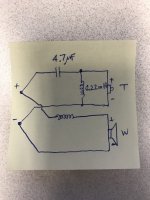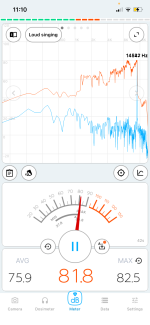I am working on some speakers that have had the bass driver swapped out and sound like they are lacking in mid range.
The tweeter is a Vifa D19SD which seems to be a higher power version of the D19TD that I understand is usually crossed over at around 5kHz.
The crossover has a series 3.3uF cap and inductor (unknown value) across the tweeter, and a series inductor (unknown value) for the woofer. So a combination first order and second order.
I don’t know what the original woofer was, so am only guessing re what the crossover frequency is.
The replacement woofer looks designed more as a subwoofer and has a stated range to 4KHz, 91dB efficiency (vs 89 for the tweeter).
So….I wanted to confirm that for this crossover design, swapping the tweeter phase is not going to make any difference?
If the previous statement is true, then the only way to recover some midrange is to drop the crossover frequency, so I was going to try a 6.8uF cap to start, and adjust by ear. Potentially lose some power handling capacity.
These are freebies for my niece so not trying to get them perfect, or to invest too much into it ;-)
The tweeter is a Vifa D19SD which seems to be a higher power version of the D19TD that I understand is usually crossed over at around 5kHz.
The crossover has a series 3.3uF cap and inductor (unknown value) across the tweeter, and a series inductor (unknown value) for the woofer. So a combination first order and second order.
I don’t know what the original woofer was, so am only guessing re what the crossover frequency is.
The replacement woofer looks designed more as a subwoofer and has a stated range to 4KHz, 91dB efficiency (vs 89 for the tweeter).
So….I wanted to confirm that for this crossover design, swapping the tweeter phase is not going to make any difference?
If the previous statement is true, then the only way to recover some midrange is to drop the crossover frequency, so I was going to try a 6.8uF cap to start, and adjust by ear. Potentially lose some power handling capacity.
These are freebies for my niece so not trying to get them perfect, or to invest too much into it ;-)
You're probably right there. But the SD version of this tweeter is rated at 350W instead of the 100W of the TD.
To my other question - first vs second order phasing. If I add a cap across the woofer, does that then create an additive effect and a peak at the crossover point? Counter intuitive but I might replace the series cap with a 4.7uF and the try moving the 3.3uF to put across the woofer terminals.
I'm guessing the inductor is 0.33mH based on the Vifa recommended design for a 5kHz filter.
To my other question - first vs second order phasing. If I add a cap across the woofer, does that then create an additive effect and a peak at the crossover point? Counter intuitive but I might replace the series cap with a 4.7uF and the try moving the 3.3uF to put across the woofer terminals.
I'm guessing the inductor is 0.33mH based on the Vifa recommended design for a 5kHz filter.
What matters for phase is the acoustic response, not the electrical filter topology. The woofer might well have a 2nd order acoustic roll-off, even though the filter is 1st order electrical.
Have you tried temporarily shorting out the inductor in series with the woofer?
The replacement woofer may have sufficient natural roll-off not to require the inductor.
The replacement woofer may have sufficient natural roll-off not to require the inductor.
The replacement woofer looks designed more as a subwoofer and has a stated range to 4KHz, 91dB efficiency (vs 89 for the tweeter).
Can you provide a datasheet or a link with some more info?
I can’t find a frequency response plot anywhere but here are the main specs. https://www.techtronics.com.au/p/105820/SPEAKERS_7_-_8.9/NoBrand/C3024.asp
The box size is about right, I extended the port to about 18cm, as long as I could while still having some space between the back of the speaker.
Tweeter: http://site.diy-loudspeakers.com/images/datasheets/loudspeakers/vifa/DISC_VIFA/D19SD05-08.pdf
That’s also a good point re the top end roll off, I’ll give that a try.
The box size is about right, I extended the port to about 18cm, as long as I could while still having some space between the back of the speaker.
Tweeter: http://site.diy-loudspeakers.com/images/datasheets/loudspeakers/vifa/DISC_VIFA/D19SD05-08.pdf
That’s also a good point re the top end roll off, I’ll give that a try.
The woofer brand is Redback.
Here’s an interesting related post: https://audiokarma.org/forums/index.php?threads/goodmans-havant-sl-repair-upgrade.600421/
Here’s an interesting related post: https://audiokarma.org/forums/index.php?threads/goodmans-havant-sl-repair-upgrade.600421/
Trying to avoid going down a rabbit hole here, I was just looking at the Peerless TC9, $20 a pop…I could move the port to the back and make it a 3 way ;-)

Well, there could well be a hole in the midrange. Manufacturer's claims for driver frequency range are often pretty meaningless, and the woofer certianly looks like it might roll off well before 4 kHz. The trouble is, how do you know for sure unless you measure?
If there is a midrange hole, a TC9 might well be a solution, but then you have the problem of coming up with a suitable 3 way crossover, when you don't know where the woofer is rolling off. That's hoping for a miracle, really.
While normally you wouldn't want to push that 19mm tweeter too low, you're up against it here, and it might be worth trying a bigger cap. I'd go for a small increase, though, at first - something like 4.3 uF would give a decent increase in level in the lower treble - maybe about 3dB in the 2-3 kHz range. The danger is,that if the hole is below that, you'll get even more boom and tizz. But it's worth a try, maybe. (I'd try @Galu's suggestion first, mind you.)
If there is a midrange hole, a TC9 might well be a solution, but then you have the problem of coming up with a suitable 3 way crossover, when you don't know where the woofer is rolling off. That's hoping for a miracle, really.
While normally you wouldn't want to push that 19mm tweeter too low, you're up against it here, and it might be worth trying a bigger cap. I'd go for a small increase, though, at first - something like 4.3 uF would give a decent increase in level in the lower treble - maybe about 3dB in the 2-3 kHz range. The danger is,that if the hole is below that, you'll get even more boom and tizz. But it's worth a try, maybe. (I'd try @Galu's suggestion first, mind you.)
Connect only the woofer directly to the amp and play some frequencies from 1-10kHz. That will show you where it starts to rolloff.
You can use some online generator thru smartphone or laptop.
You can use some online generator thru smartphone or laptop.
The midbass - tweeter distance is too big. Especially if you cut it at 4kHz. Try turning the phase on the tweeters. Find some frequency range app for android phone (Spectroid etc.). Using an online generator and amplifier, you play white noise on the speakers and watch the response on the phone. It is mostly accurate from 100Hz to 15kHz.
This is what I was asking. Say I take out the series inductor from the woofer, a second order filter on the tweeter would then best be connected with the correct polarity, right?
Try some measurement. Because no one can tell you straight away what and how. By removing the series inductance on the midbass, both the phase and the impedance will change. Also, without changing the crossover, just turning the phase on the tweeters will maybe add and maybe take away some of the midrange frequencies. That's why you should try it first.
Swapping the tweeter phase is going to make the difference. Speaker crossover is a network so that every component in a crossover will effect the sound from all the drivers in that network.
For testing correct tweeter polarity you can use same method as in post #11.
Play some frequencies around crossing point, say 3-6kHz. If polarity is wrong, the drivers will cancel each other giving a certain "hole" in response at crossing point. If polarity is correct they will sum, with more/less same output.
Play some frequencies around crossing point, say 3-6kHz. If polarity is wrong, the drivers will cancel each other giving a certain "hole" in response at crossing point. If polarity is correct they will sum, with more/less same output.
Can anyone recommend a frequency generator app? I can connect to the amp via a bluetooth adapter
Well, that was a learning exercise.
I tried shorting the inductor on the woofer, putting in a different capacitor, and also swapping the polarity of the tweeter.
I ran a couple of frequency plots and they were consistent in each scenario, even though I suspect there’s some factors that influenced them overall. (The regular dropouts were from the generator, not sure why but it kept pausing)
There seems to be a large peak in the tweeter around 13kHz. That also appears to be the limit of my hearing range, so it’s not apparent when listening. There’s also a dip between 4-5kHz in the starting setup.

- Shorting out the inductor actually created a larger dip around 4kHz. Makes no sense to me.

- Changing the cap to 6.8uF (only value I had at hand) created the smoothest response but added a peak around 3-4k

- Swapping the polarity of the tweeter also improved things, with a smaller peak at 3kHz. I think I’ll run with this, and test an increase in the cap to 4.7k.

Thanks for all the suggestions!
I tried shorting the inductor on the woofer, putting in a different capacitor, and also swapping the polarity of the tweeter.
I ran a couple of frequency plots and they were consistent in each scenario, even though I suspect there’s some factors that influenced them overall. (The regular dropouts were from the generator, not sure why but it kept pausing)
There seems to be a large peak in the tweeter around 13kHz. That also appears to be the limit of my hearing range, so it’s not apparent when listening. There’s also a dip between 4-5kHz in the starting setup.
- Shorting out the inductor actually created a larger dip around 4kHz. Makes no sense to me.
- Changing the cap to 6.8uF (only value I had at hand) created the smoothest response but added a peak around 3-4k
- Swapping the polarity of the tweeter also improved things, with a smaller peak at 3kHz. I think I’ll run with this, and test an increase in the cap to 4.7k.
Thanks for all the suggestions!
Attachments
- Home
- Loudspeakers
- Multi-Way
- Tweeter phase for first/second order crossover

